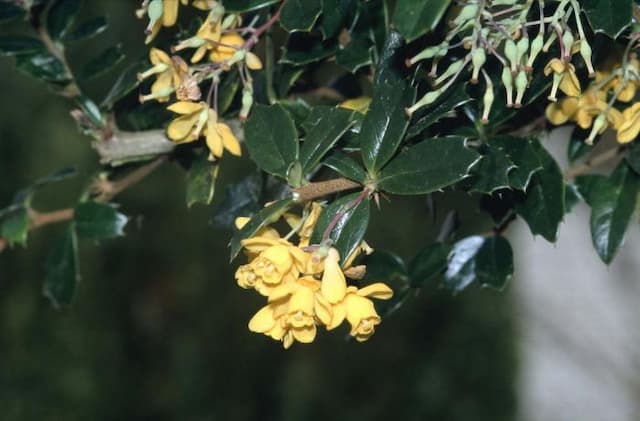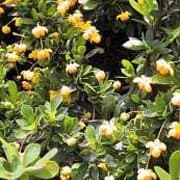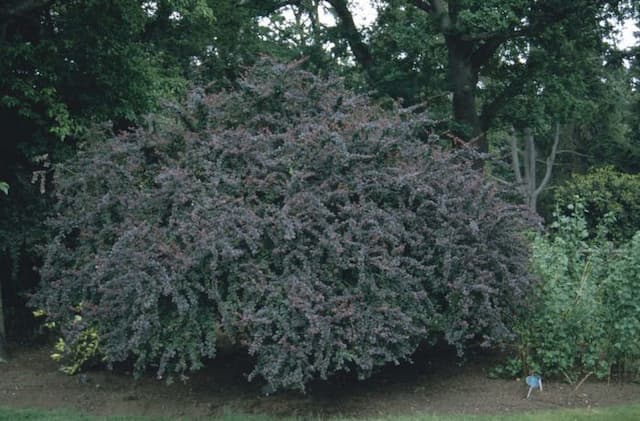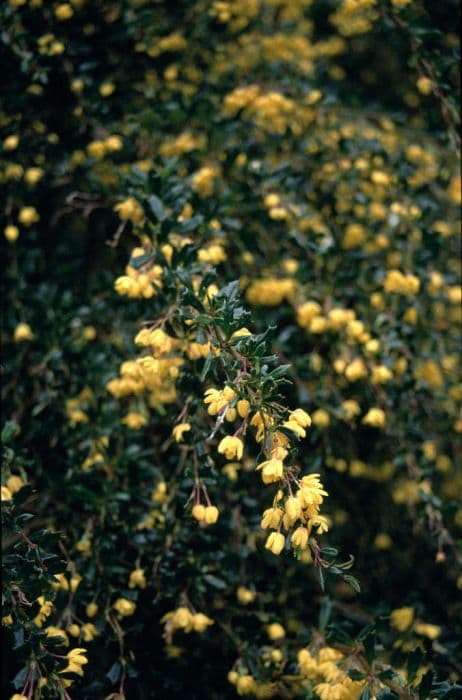Red Jewel Barberry Berberis × media 'Red Jewel'

ABOUT
'Red Jewel' is a compact and dense shrub that is widely appreciated for its ornamental qualities. Its leaves are small, glossy, and have a deep green color, which contrasts strikingly with the vivid red tones that they exhibit during the fall season, making it a plant with high visual interest throughout the year. In addition to its foliage, 'Red Jewel' also produces small, bright yellow flowers in the spring, which are clustered together in an attractive display. These blossoms are a source of nectar for various pollinators and often give way to small, oval-shaped berries. The berries have a bright red hue that persists well into winter, adding a splash of color to the landscape during the colder months and providing food for birds and other wildlife. The plant's stems are covered with sharp thorns, which can make it useful for hedge or barrier plantings where a deterrent effect is desired. Overall, 'Red Jewel' is a hardy shrub that combines beauty with functionality, offering multi-season interest and adaptability to a variety of garden settings.
About this plant
 Names
NamesSynonyms
Red Jewel Barberry
Common names
Berberis × media 'Red Jewel'.
 Toxicity
ToxicityTo humans
The Red Jewel barberry is considered to have some level of toxicity to humans. Like many other members of the Berberis family, it contains alkaloids such as berberine that can cause adverse effects if ingested. The most common symptoms of poisoning from consuming parts of this plant are gastrointestinal in nature, including nausea, vomiting, diarrhea, and abdominal pain. Ingestion of large quantities could potentially lead to more serious health issues, so care should be taken to prevent accidental consumption, especially among children who might be attracted to the berries.
To pets
The Red Jewel barberry is also toxic to pets. The alkaloid compounds, especially berberine, present in the plant can lead to similar gastrointestinal symptoms as those seen in humans. If a pet ingests part of this barberry, they may exhibit signs of poisoning such as vomiting, diarrhea, lethargy, and loss of appetite. It's important for pet owners to keep animals away from the plant to prevent ingestion and to seek veterinary attention if they suspect their pet has consumed any part of it.
 Characteristics
CharacteristicsLife cycle
Perennials
Foliage type
Evergreen
Color of leaves
Red
Flower color
Yellow
Height
4 feet (1.22 meters)
Spread
4 feet (1.22 meters)
Plant type
Shrub
Hardiness zones
6
Native area
Hybrid
Benefits
 General Benefits
General Benefits- Attractive Foliage: Berberis × media 'Red Jewel' has leaves that turn vibrant colors in the fall, providing seasonal interest in the garden.
- Durability: This shrub is known for being tough and can survive in a variety of soil types, making it a reliable choice for landscapers.
- Low Maintenance: Once established, it requires minimal care, making it a great option for those who do not have a lot of time for gardening.
- Structural Plant: Its dense, compact growth habit makes it ideal for creating hedges or as a structural element in garden design.
- Drought Tolerance: It can withstand periods of dry weather, which is beneficial in regions that experience water scarcity.
- Pest Resistance: It is fairly resistant to pests, reducing the need for chemical interventions in the garden.
- Wildlife Attraction: The berries of the plant can attract birds, providing a natural source of food and aiding in biodiversity.
- Architectural Interest: With its sharp thorns and structured growth, it adds an architectural element to gardens and can be used for security purposes as a barrier plant.
 Medical Properties
Medical PropertiesThis plant is not used for medical purposes.
 Air-purifying Qualities
Air-purifying QualitiesThis plant is not specifically known for air purifying qualities.
 Other Uses
Other Uses- Berberis × media 'Red Jewel', commonly known as Red Jewel Barberry, can serve as a natural dye source; the berries produce a yellow or greenish-yellow dye used in textile coloring.
- The spiny branches of the Red Jewel Barberry can be utilized in barriers or living fences to deter animals and unauthorized entry into private areas.
- The dense growth habit of the plant provides excellent cover for birds and small wildlife, offering them protection and a habitat.
- Its berries are sometimes used in crafts and ornamentation, especially for autumn and winter-themed decorations.
- The plant's thorns can be used in traditional fish traps or bird snares as a rural hunting or fishing technique.
- Red Jewel Barberry works well in bonsai culture, with enthusiasts valuing its colorful foliage and suitability for shaping.
- The wood, being hard and dense, can be carved into small tools or used for inlay work in woodworking projects.
- Its colorful foliage can be used in floral arrangements to provide contrasting color and texture.
- When planted in mass or as a hedge, it can act as a windbreak, reducing erosion and protecting smaller, less hardy plants.
- As a companion plant in gardens, it can help deter certain pests due to its thorny branches and possibly due to the chemicals found in its roots and foliage.
Interesting Facts
 Feng Shui
Feng ShuiThe Japanese Barberry is not used in Feng Shui practice.
 Zodiac Sign Compitability
Zodiac Sign CompitabilityThe Japanese Barberry is not used in astrology practice.
 Plant Symbolism
Plant Symbolism- Protection: Berberis, commonly known as "Barberry," is often associated with protection due to its thorny branches, which can create a natural barrier against intruders.
- Purification: Barberry has medicinal properties and has been used for cleansing the body, leading to its symbolic association with purification.
- Sinfulness: With its sharp thorns and sometimes sour berries, Barberry can symbolize sin or wrongdoing in certain cultural contexts.
 Water
WaterThe Red Jewel Barberry should be watered deeply, ensuring the soil is moist but not waterlogged. During the growing season, watering once a week with approximately 1-2 gallons per plant is usually sufficient. Adjustments may be needed depending on climate and weather conditions; less frequent watering is required during the fall and winter months. During periods of drought or extreme heat, monitoring the soil moisture closely and watering every few days may be necessary.
 Light
LightThe Red Jewel Barberry thrives in full sun to partial shade. The ideal spot for this plant is one where it receives at least 6 hours of direct sunlight daily, which ensures the richest foliage color and optimal growth. While it can tolerate some shade, too much can lead to reduced vibrancy and a less compact growth habit.
 Temperature
TemperatureThe Red Jewel Barberry is hardy and can tolerate a wide range of temperatures, but it performs best when the temperature is between 40°F and 85°F. While it can survive in temperatures as low as -20°F and as high as 90°F for short periods, prolonged exposure beyond this range can stress the plant.
 Pruning
PruningPruning the Red Jewel Barberry helps to maintain its shape, encourage branching, and remove any dead or diseased wood. It's best pruned in late winter or early spring before new growth begins. Pruning may also be done after the plant has flowered to minimize the loss of next year's blooms, though this species is primarily grown for its foliage.
 Cleaning
CleaningAs needed
 Soil
SoilRed Jewel Barberry prefers well-drained soil with a slightly acidic to neutral pH, between 5.5 to 7.0. A mix of garden soil, compost, and peat moss is ideal, ensuring good aeration and drainage to prevent root rot.
 Repotting
RepottingRed Jewel Barberry is typically a slow grower and doesn’t require frequent repotting; every 2-3 years or when rootbound is sufficient.
 Humidity & Misting
Humidity & MistingRed Jewel Barberry is relatively tolerant of different humidity levels and thrives in average outdoor conditions; excessive humidity is not necessary.
 Suitable locations
Suitable locationsIndoor
Place in bright light, cool temperature, water sparingly.
Outdoor
Full sun to part shade, protect from wind, well-draining soil.
Hardiness zone
5-8 USDA
 Life cycle
Life cycleThe Red Jewel Barberry, like most perennial shrubs, begins its life cycle with germination, which occurs when seeds, often dispersed by birds who eat the berries, find suitable soil and conditions to sprout. This is followed by the seedling stage, where the plant begins to establish its root system and first leaves (cotyledons). As it enters the juvenile phase, the plant develops its characteristic spiny branches and foliage, and it may take several years before it reaches maturity and begins to flower. Once mature, the Red Jewel Barberry annually produces small yellow flowers in the spring, which are pollinated by insects and subsequently develop into bright red, jewel-like berries. These berries not only add ornamental value but also serve to disperse seeds for the next generation. The plant continues this cycle of flowering and fruiting for many years, sometimes several decades, until it reaches the end of its lifespan and dies, completing the life cycle.
 Propogation
PropogationPropogation time
Early Spring
The most popular method of propagation for the Berberis × media 'Red Jewel', commonly known as Barberry, is through semi-hardwood cuttings. This process is typically carried out in the late summer. To propagate, one must select a healthy, disease-free stem and cut a 4 to 6 inch (10 to 15 cm) long section, ensuring that there are several leaves on the cutting. The lower leaves are then removed, and the cut end is dipped in rooting hormone to encourage root development. The prepared cutting is then inserted into a pot filled with a well-draining potting mix, with about half the length of the cutting submerged. The pot should be kept in a warm, humid environment and the soil should be kept consistently moist, but not waterlogged. Roots typically develop in a few weeks, after which the new plant can eventually be planted out.









